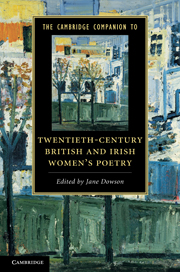Book contents
- Frontmatter
- 1 Introduction
- 2 Post/Modernist rhythms and voices: Edith Sitwell and Stevie Smith to Jo Shapcott and Selima Hill
- 3 Reframing women’s war poetry
- 4 Verbal and visual art in twentieth-century British women’s poetry
- 5 Towards a new confessionalism
- 6 The mid-Atlantic imagination: Mina Loy, Ruth Fainlight, Anne Stevenson, Anne Rouse and Eva Salzman
- 7 The Irish history wars and Irish women’s poetry: Eiléan Ní Chuilleanáin and Eavan Boland
- 8 Interculturalism: Imtiaz Dharker, Patience Agbabi, Jackie Kay and contemporary Irish poets
- 9 Post-pastoral perspectives on landscape and culture
- 10 Feminism’s experimental ‘work at the language-face’
- 11 Carol Ann Duffy, Medbh McGuckian and ruptures in the lines of communication
- Selected reading
- Index
10 - Feminism’s experimental ‘work at the language-face’
Published online by Cambridge University Press: 28 May 2011
- Frontmatter
- 1 Introduction
- 2 Post/Modernist rhythms and voices: Edith Sitwell and Stevie Smith to Jo Shapcott and Selima Hill
- 3 Reframing women’s war poetry
- 4 Verbal and visual art in twentieth-century British women’s poetry
- 5 Towards a new confessionalism
- 6 The mid-Atlantic imagination: Mina Loy, Ruth Fainlight, Anne Stevenson, Anne Rouse and Eva Salzman
- 7 The Irish history wars and Irish women’s poetry: Eiléan Ní Chuilleanáin and Eavan Boland
- 8 Interculturalism: Imtiaz Dharker, Patience Agbabi, Jackie Kay and contemporary Irish poets
- 9 Post-pastoral perspectives on landscape and culture
- 10 Feminism’s experimental ‘work at the language-face’
- 11 Carol Ann Duffy, Medbh McGuckian and ruptures in the lines of communication
- Selected reading
- Index
Summary
With what voices do women poets speak? In avant-garde, experimental or Language Poetry (to throw in three assorted and not particularly helpful labels), there is no unified lyric voice – its claims are exploded, its modes of expression done to death. In its place, we … follow the text in all its provisionality, its multiple meanings, its erasures, silences, chora.
I do not want to make it cohere
voices all well put down then
Women’s voices vex literary histories of recent British poetry, whether cast as ‘mainstream’ or as ‘postmodern’, categories routinely invoked and questioned and invoked again, but nonetheless defined primarily in terms of male poets. Familiar narratives paint a picture of poetry retreating after World War II into an insular and provincial Englishness, a rejection of modernist experimentation that really begins before the war but finds its fullest popularity in the everyman poetry of the Movement. That an active continuation of modernist poetics persisted alongside the more dominant Movement – under the various labels of neo-modernism, postmodernism, innovative, experimental and/or alternative poetics – has remained relatively overlooked by critics, ignored by publishing powers and unsupported by arts funding through the later decades of the twentieth century. If the British experimental scene is a ‘stretched and resolutely unnamed map of divergent factions, mostly held together by the poets themselves and a few critics’, what mappings exist focus, by and large, on men, too often ignoring not only the creative work of women but the political, theoretical and activist feminisms mediating their gender-aware constructs of the ‘experimental’.
- Type
- Chapter
- Information
- Publisher: Cambridge University PressPrint publication year: 2011
- 1
- Cited by



